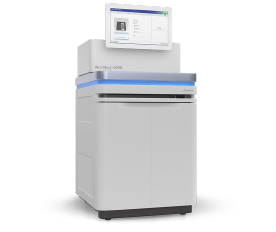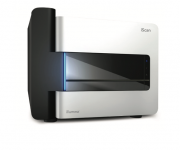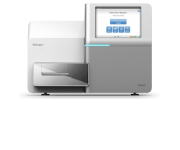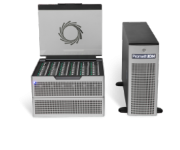Genomics and Epigenomics Laboratory
The Genomics and Epigenomics Laboratory at the Area Science Park is a facility dedicated to analysing DNA and RNA sequences and genotyping (microarrays). The laboratory has been an Illumina Propel-Certified Service Provider for Infinium genotyping since 2018, and for the MiSeqDX instrument since 2020.
Data sequencing and/or analysis services
- Human, animal and microbial genome and transcriptome sequencing and analysis (DNA-seq and RNA-seq)
- Human exome sequencing and analysis
- Gene panel sequencing analysis
- Microbiome sequencing and analysis through taxonomic marker sequencing (16S/ITS), metagenomics and amplicon sequencing
- Metagenomic sequencing in matrices of various types (food, soil etc.) through taxonomic marker sequencing (16S/ITS) and amplicon sequencing
- MiRNA-seq and small RNA-seq sequencing for post-transcriptional gene regulation analysis, ChIP-seq to analyse DNA and histone protein interactions
- Genotyping with Microarrays
Learn about our laboratory
- Sequencing instrumentation
- Laboratory equipment
- Protocols
- Computational software and pipelines
- Data centre supporting data management
Sequencing instrumentation
 NovaSeq 6000
NovaSeq 6000
A flexible, ultra-high throughput DNA sequencing system capable of sequencing up to 48 human genomes at a 30-fold depth in a single instrument run. The instrument offers multiple flow cell formats, various read length configurations and the ability to analyse one or two flow cells at the same time to obtain data output ranging from approximately 160 Gb to 6 Tb and up to 20 billion reads per run, providing flexibility across a wide range of study applications and sizes.
 iScan System
iScan System
An innovative array scanner that provides fast, sensitive and accurate imaging of Illumina BeadChips. The iScan system is part of Illumina’s comprehensive portfolio of innovative assays for genotyping, copy number variation (CNV) analysis and DNA methylation. The scanners and components are modular, creating a system that can be synchronised and configured in accordance with varying levels of required sample throughput. The iScan system uses high performance lasers, optics and sensing systems to provide submicron resolution and high throughput. As a result, scan times are extremely fast while preserving data quality and reproducibility.
 MiSeqDX
MiSeqDX
A massive parallel sequencing platform to be used both in certified IVD (In Vitro Diagnostic) and RUO (Research Use Only) analysis. Illumina’s MiSeqDX System connects Illumina’s sequencing by synthesis (SBS) technology with a workflow that enables researchers to obtain analysed data from DNA samples in as little as eight hours (8h), producing up to 15 gigabases of data in a single instrument run, 25 million reads with a length of 2×300 bp each and base call accuracy parameters greater than 99.9%. MiSeq incorporates cluster generation, sequencing and data analysis functions on a single instrument with full automation and flexibility to process limited numbers of samples.
 PromethION 24
PromethION 24
PromethION 24 offers direct, real-time DNA and RNA sequencing technology capable of long readings of single molecules. The PromethION 24 system is designed to run 24 flow cells, allowing for on-demand sequencing, using any flow cell at any time. The running of single experiments can be started and stopped as required or multiple flow cells can be deployed onto single experiments for greater speed or throughput. Each flow cell allows up to 3,000 nanopores to be sequenced simultaneously, with a yield of > 4.8 Tb.
Laboratory equipment
The laboratory extends over an area of 220 square metres, housing 20 workstations on workbenches, one fume hood workstation and one horizontal laminar flow hood workstation. The workstations are set up with the following ancillary equipment used to prepare and handle samples during preliminary and preparatory processing for sequencing:
- Semi-automated TECAN EVO apparatus for parallel processing of 384 samples for the Infinium protocol (Tecan)
- Illumina Hybridization Oven (Illumina)
- Bioanalyzer (Agilent Technologies)
- PCR StepOnePlus (Applied Biosystem)
- NanoDrop (Thermo Fisher Scientific)
- cBot Cluster Generation System (Illumina)
- Covaris M220 ultrasonicator (Covaris)
- 4200 TapeStation system (Agilent Technologies)
- Class II biological safety cabinet certified to EN12469
Protocols
Non-proprietary laboratory protocols based on commercial reagent kit and instrumentation manuals drawn up by Promega, QIAGEN, Illumina, NuGEN, Roche, Agilent Technologies, and/or on protocols published in scientific articles, are followed for DNA and RNA sample handling, quality control and library preparation in relation to the aforementioned services.
The data analysis protocols used are based on open-source software or software licensed by Illumina for the phases common to all applications of:
- conversion of Illumina data from binary to raw sequence in FASTQ text format;
- demultiplexing of samples (bcl2fastq);
- masking of adapter sequences and quality control (FastQC, Cutadapt);
- removal of low-quality sequence portions and contaminating sequences (ERNE-filter, BBDuk).
Computational software and pipelines
The Laboratory has data analysis pipeline processes, developed internally for the following applications, which incorporate open-source software and proprietary programs:
- analysis of human, animal and microbial genomes, exomes and transcriptomes (DNA-seq and RNA-seq) for differential gene expression analysis (HTSeq-count, DESeq), identification of single nucleotide variants (GATK), copy number variation and other structural variants (DNAcopy, proprietary scripts);
- conversion of data formats (Picard tools, Samtools, proprietary scripts);
- gene panel analysis (BWA-MEM, GATK, ANNOVAR);
- metagenomic analysis on human microbiome and on samples of plants, animals and microorganisms and matrices of various types (foodstuffs, soil etc.) based on QIIME 2;
- genotyping using Microarrays (proprietary scripts);
- analysis of single nucleotide variants in target regions (GATK).